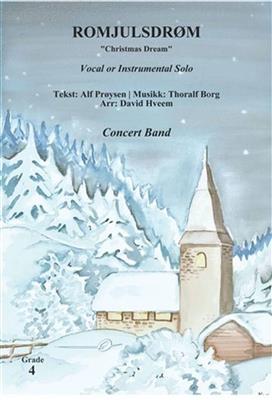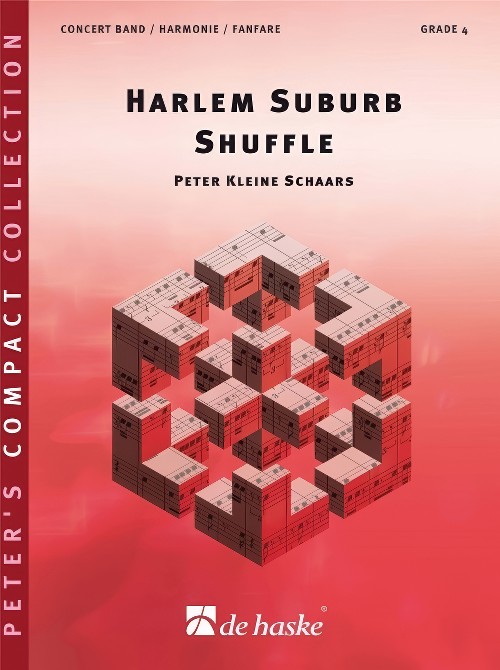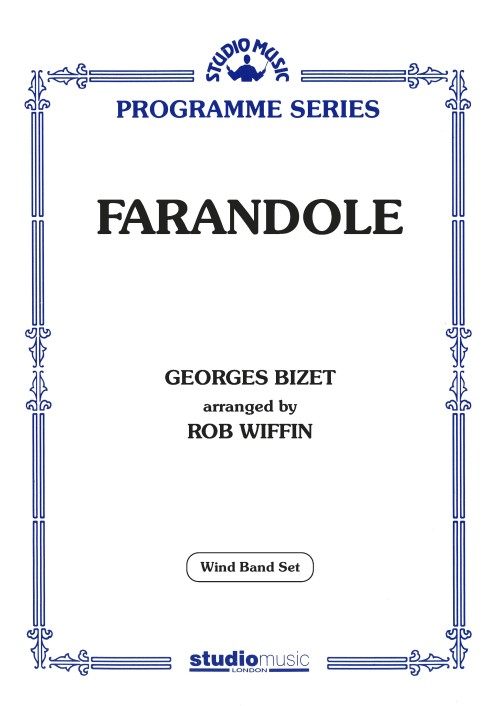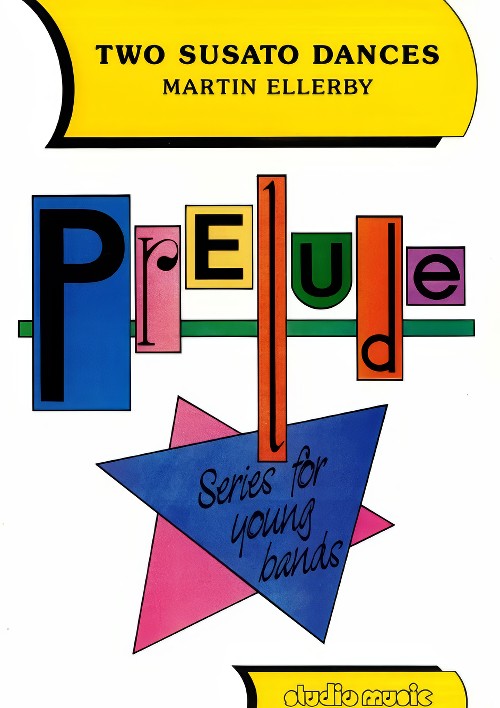Results
-
 £248.99
£248.99Missa Brevis Wind Band Set (Score & Parts)
Missa Brevis, written for choir and wind band, was commissioned by the Conseil D?partemental pour la Musique et la Culture de Haute-Alsace (Dir.: Philippe Pfisterer) in Guebwiller (France), in celebration of the millennium of Pope Leon IX's birth in ?guisheim (France). The composer conducted the first performance on June 23, 2002. It was performed live for the French television channel France 2. The mass movements Kyrie, Gloria, Credo, Sanctus, Benedictus, and Agnus Dei are very suitable for the Catholic as well as the Protestant liturgy. For this mass, various ways for performing in diverse variable strengths are possible. An instrumental performance is possible if the brass represents the choir parts. In this option, it is desirable for the brass to be positioned separately from the rest of the band (on a gallery, for example), so that the idea of two choirs is approached. In a performance with a large choir, the brass can work very well as a support. In that case, the dynamics of the brass should be adapted somewhat, since these are actually intended for an instrumental performance. You can also leave out the brass entirely for the benefit of the choir. For the accompaniment of smaller choirs, you can opt for a small ensemble from the band. This can also be a quartet, put together as desired. For the performance of this mass, the obvious choice is one of the above options. However, as an alternative, a performance with a combination of these options (vocally/instrumentally) is also possible - not just from an artistic point of view (variation), but also from a practical starting point - for example in the case that the choir has rehearsed only two movements. With a full strength, the conductor can vary the instrumentation to his or her liking. Then the brass can also play a role in the accompaniment (instead of supporting the choir). The following combinations are possible: 1. clarinet choir (from Eb Clarinet to Bass Clarinet) 2. clarinet choir + saxophones 3. brass (flugelhorns, horns, euphoniums, bass section) 4. brass (2 trumpets / 2 trombones) 5. double reeds (optional + flute, optional + string bass) 6. tutti 7. all winds 8. all brass In a performance by brass band and choir, it is usually advisable to leave out option 1 (choir + brass + band). The choir sings self-reliantly, accompanied by a full brass band. In an instrumental performance, you can consider a combined quartet (two cornets and two trombones) + brass band. Choral parts available separately. 0:20:00
Estimated dispatch 7-14 working days
-
 £115.60
£115.60Romjulsdrm - Thoralf Borg
The poem Romjulsdrm ("Christmas Dream") was first published in Arbeiderbladet on January 3rd 1959, and became known when Thoralf Borg set a melody to it in 1968. Up until this, Alf Prysen had used a melody quite similar to the song Lijan uti dalen, when he sang the song in the TV program Ei vise vil jeg synge in 1964. At the same time that Borg's melody was written, the last four lines of text were also added to the poem, and the song took on the form we know today.The form and structure of this arrangement originates from a version for big band and vocals commissioned by stre Toten Storband, written in 2018 for one of their traditional midnight concerts on the day before Christmas. In an attempt to give the arrangement a nice calm and the text a lot of room, as is often the case in songs like this, it ended up in a relatively narrative style where the variation in tempo and the shifts between swing and straight eighth notes are particularly central.The song is about family, friendship and the quiet days of the Christmas holidays, which hopefully is something most people can recognise. The arrangement for the aforementioned midnight concert was ordered because my sister was to be the soloist for the concert, and since my father also played lead trombone - as he has done in this big band for as long as I can remember - it was natural to add a small trombone solo as well. It's always special to write and arrange music for people I know and appreciate, but it's extra special when it's also for two of my great role models.- David Stre Hveem -
Estimated dispatch 7-14 working days
-
 £144.99
£144.99Gloriosa - Symphonic Poem for Band Movement 1 - Yasuhide Ito
A new acquisition by Bravo Music, this fresh printing of the 1990 masterwork by Yasuhide Ito features a newly engraved score, improved parts, good availability and value. This stirring and powerful homage to early Christianity in Japan profoundly andeloquently states the case of cross-cultural conflict and resolution.I. OratioThe Gregorian chant "Gloriosa" begins with the words, "O gloriosa Domina excelsa super sidera que te creavit provide lactasti sacro ubere." The first movement Oratio opens with bells sounding the hymn's initial phrases. The movement as a whole evokesthe fervent prayers and suffering of the Crypto-Christians.II. CantusIII. Dies FestusCommissioned in 1989 and premiered in 1990 by the Sasebo Band of the Maritime Self-Defense Force of Kyushu, southern Japan.Gloriosa is inspired by the songs of the Kakure-Kirishitan (Crypto-Christians) of Kyushu who continued to practice their faith surreptitiously after the ban of Christianity, which had been introduced to that southern region in the mid-16th century byRoman Catholic missionary Francisco Xavier. The worship brought with it a variety of western music.
Estimated dispatch 7-14 working days
-
£144.99
Gloriosa - Symphonic Poem for Band Mvt 2 & 3 - Yasuhide Ito
A new acquisition by Bravo Music, this fresh printing of the 1990 masterwork by Yasuhide Ito features a newly engraved score, improved parts, good availability and value. This stirring and powerful homage to early Christianity in Japan profoundly andeloquently states the case of cross-cultural conflict and resolution.I. OratioII. CantusThe second movement, Cantus showcases a brilliant blend of Gregorian chant and Japanese elements by opening with a solo passage for the ryuteki, a type of flute. The theme is based on San Juan-sama no Uta (The Song of Saint John), a 17th-century songcommemorating the "Great Martyrdom of Nagasaki" where a number of Kyushu Christians were killed in 1622.III. Dies FestusThe third and final movement, Dies Festus, takes as its theme the Nagasaki folk song, Nagasaki Bura Bura Bushi, where many Crypto-Christians lived.Commissioned in 1989 and premiered in 1990 by the Sasebo Band of the Maritime Self-Defense Force of Kyushu, southern Japan.Gloriosa is inspired by the songs of the Kakure-Kirishitan (Crypto-Christians) of Kyushu who continued to practice their faith surreptitiously after the ban of Christianity, which had been introduced to that southern region in the mid-16th century byRoman Catholic missionary Francisco Xavier. The worship brought with it a variety of western music.
Estimated dispatch 7-14 working days
-
£89.99
Coro degli Armigeri - Giuseppe Verdi
A technique much employed by Verdi is to alternate main scenes of a drama with others which allow the listener to relax temporarily. These moments are often entrusted to the choir (as in the case of the well-known Rataplan in La forza del destino). In Trovatore, the soldiers' chorus precedes the scene of the capture of the gipsy woman Azucena by Conte di Luna's men. The soldiers are about to attack the fortress of Castellor in which Manrico (the troubadour) and Leonora, together with many other rebels, have found shelter. The very easy-going choir is in blunt contrast to the following scene in which Ferrando, the loyal squire of Conte di Luna, recognizes theold gipsy woman. This recognition marks the beginning of wicked developments for all protagonists in this drama.
Estimated dispatch 7-14 working days
-
 £267.50
£267.50Gloriosa - Symphonic Poem for Band (Complete) - Yasuhide Ito
A new acquisition by Bravo Music, this fresh printing of the 1990 masterwork by Yasuhide Ito features a newly engraved score, improved parts, good availability and value. This stirring and powerful homage to early Christianity in Japan profoundly andeloquently states the case of cross-cultural conflict and resolution.Commissioned in 1989 and premiered in 1990 by the Sasebo Band of the Maritime Self-Defense Force of Kyushu, southern Japan.Gloriosa is inspired by the songs of the Kakure-Kirishitan (Crypto-Christians) of Kyushu who continued to practice their faith surreptitiously after the ban of Christianity, which had been introduced to that southern region in the mid-16th century byRoman Catholic missionary Francisco Xavier. The worship brought with it a variety of western music.Though Christianity was proscribed in 1612 by authority of the Tokugawa Shogunate in Edo (today Tokyo), Kakure-Kirishitan continued advocating sermons and disguised songs. Melodies and lyrics such as Gregorian chant were obliged to be "Japanized".For example, the Latin word "Gloriosa" was changed to "Gururiyoza." This adaptation of liturgy for survival inspired Ito to write this piece in order to reveal and solve this unique cultural mystery.The composer explains:"Nagasaki district in Kyushu region continued to accept foreign culture even during the seclusion period, as Japan's only window to the outer world. After the proscription of Christianity, the faith was preserved and handed down in secret in theNagasaki and Shimabara areas of Kyushu region. My interest was piqued by the way in which the Latin words of Gregorian chants were gradually 'Japanized' during the 200 years of hidden practice of the Christian faith. That music forms the basis ofGloriosa."I. OratioThe Gregorian chant "Gloriosa" begins with the words, "O gloriosa Domina excelsa super sidera que te creavit provide lactasti sacro ubere." The first movement Oratio opens with bells sounding the hymn's initial phrases. The movement as a whole evokesthe fervent prayers and suffering of the Crypto-Christians.II. CantusThe second movement, Cantus showcases a brilliant blend of Gregorian chant and Japanese elements by opening with a solo passage for the ryuteki, a type of flute. The theme is based on San Juan-sama no Uta (The Song of Saint John), a 17th-century songcommemorating the "Great Martyrdom of Nagasaki" where a number of Kyushu Christians were killed in 1622.II. Dies FestusThe third and final movement, Dies Festus, takes as its theme the Nagasaki folk song, Nagasaki Bura Bura Bushi, where many Crypto-Christians lived.Gloriosa, fusing Gregorian chant and Japanese folk music, displays the most sophisticated counterpoint yet found in any Japanese composition for wind orchestra.
Estimated dispatch 7-14 working days
-
 £129.99
£129.99Aquarium - Johan de Meij
The Suite 'Aquarium' is Johan de Meij's third composition for symphonic band and features six tropical fishes, each of them represented by a motif, and surfacing as such in several guises. The composition consists of three movements of which the second and third merge uninterruptedly into each other. I) Allegretto grazioso (Neon Tetra, Electric Eel and Angelfish) II) Andante / Adagio (Sea Horse and Zebrafish) III) Finale: Allegro giocoso (Guppy & Co.) The Neon Tetra motif functions as a kind of 'Leitmotiv' and descibes the beautifully coloured, frisky fish: A number of variants have been derived from this theme and will also appear in the other movements.The Electric Eel in fact is not represented by a motif, but by a rhythm based on the restless electric pulses made audible in some aquaria. The Angel fish is represented by elegant cluster chords. In the second movement the Sea Horse emerges out of the water vegetation and starts a dialogue with the Zebrafish, which is represented by one melodic phrase in unison, getting more and more threatening by added parallel fifths and octaves. Simultaneously with the Sea Horse motif the Neon Tetra theme emerges, this time in 3/4 time and in Eb minor. The third movement starts with only two instruments (trumpet and xylophone), but as it is often the case with Guppies their number rapidly increases. Piccolo and Alto Saxophone introduce the Guppy Theme followed by several instrumental combinations. Every theme from the first movement 'swims by' once more, after which the principal motif leads us to a brilliant ending.
Estimated dispatch 7-14 working days
-
 £72.99
£72.99Harlem Suburb Shuffle (Flexible Ensemble - Score and Parts) - Schaars, Peter Kleine
From the beginning of the Middle Ages, we have known performance practices in which the duration of the notes can differ from the actual notation. In some cases, binary written melodies were performed in a ternary way. This is also the case in the present-day shuffle: the written quavers are performed in a long-short system in which the ratio is 2:1. In other words, the performance practice is based on a triplet feel. In this composition, all ingredients of the shuffle are featured: a vigorous swing rhythm, a walking bass, the successions of thirds in the accompaniment and the frequent use of triplets. To make sure that the binary written rhythms in the accompaniments are performed in the correct ternary manner, Peter Kleine Schaars has notated the melody themes in triplets as much as possible. Thus, this composition is a very useful exercise for the swing development of your ensemble. Additionally, the work is a treat to listen to, so your audience will really appreciate this up-tempo big band like composition. All ternary rhythmic cells 17 till 24 pass in revue, further more much attention had been paid to a correct performance of cell 4 in swing feel.Duration: 3.00
Estimated dispatch 7-14 working days
-
 £64.95
£64.95Farandole (Concert Band - Score and Parts) - Bizet, Georges - Wiffin, Rob
In taking a lateral look at Bizet's famous Farandole, I decided to omit the full opening statement of the old Provencal tune Marcho dei Rei (March of the Kings), opting instead to make oblique references to it. The combination of this old Christmas song with another traditional Provencal Melody Danso dei Chivau-Frus (Dance of the Hobbyhorse) originally made by Bizet's friend Ernest Guiraud when he compiled Suite No.2 from Bizet's music to the play L'Arlesienne.The farandole is a traditional Provencal dance in which men and women hold hands in a chain and wind through the streets following a musician playing pipe and tabor. In the case of Danso dei Chivau-Frus, the lead dancer would wear a horse's head made of papier mache or something similar.I have attempted to stay true to the spirit of the Farandole and the contrapuntal devices added by Guirand while adding a few touches of interest and harmonic colour here and there.- Rob Wiffin
Estimated dispatch 7-14 working days
-
 £44.95
£44.95Two Susato Dances (Concert Band - Score and Parts) - Susato, Tielman - Ellerby, Martin
Around 1540 Tielman Susato, the Belgium trumpet player and composer, established himself in Antwerp as a printer of music. In 1551 he brought out The Third Little Music Book, a collection of instrumental dances. Most of these are arrangements, possible by Susato himself, of popular dance tunes. In keeping with sixteenth-century practice, this book details no specific instrumentation; something to be worked out by the players with whatever available means. Doubtless many of the dances were performed on wind instruments at festive outdoor events. The date of Susato's birth is unknown but estimated to be around 1500. The same applied to his death, which is thought to be somewhere between 1561-64.The third Little Music Book gives several examples of the traditional sixteenth-century genre, the dance pair, a predecessor of the Baroque suite. In such a pair the first dance was often in slow or moderate duple time, the second in quick triple time. This is the case in the pair presented here, which consists of a lively round dance followed by a Hop Up or saltarello.Titles in the Prelude Series are specifically scored for bands with few, if any, bass instruments but will sound well on larger ensembles. The bass line is playable by any combination of bass clarinet, bassoon, baritone saxophone, trombone, euphonium or tuba; in the event that none of these is available, the part for trombone/euphonium (B flat TC) can be played by tenor saxophone. The tuned percussion part is entirely optional and can be played by any available instrument(s). Each piece also includes a preliminary exercise. This is always in the same key as the accompanying piece and consists of a scale and chord progression that can be used for improving ensemble, balance, intonation and instrumental facility by changing tempo, articulation and dynamics.Duration: 2.00
Estimated dispatch 7-14 working days
